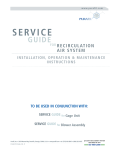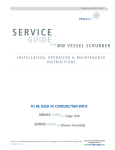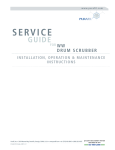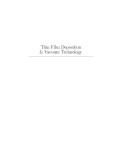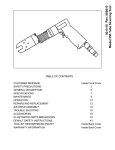Download Front Access System
Transcript
w w w. p u r a f i l . c o m FIRST CL E A N AIR IN SERVICE G U I D EFOR FRONT A C C E S S S YS T E M I N S TA L L AT I O N , O P E R AT I O N & M A I N T E N A N C E INSTRUCTIONS Purafil, Inc. • 2654 Weaver Way, Doraville, Georgia, 30340, U.S.A. • www.purafil.com • tel: (770) 662-8545 • (800) 222-6367 © Purafil 2012 SrvcGde - FAS - 01 ISO 9001:2008 TABLE OF CONTENTS 1.0 PRE-INSTALLATION INSTRUCTIONS 1.1 SAFETY CONSIDERATIONS 1.2 RECEIVING INSTRUCTIONS 1.3 INSPECTION 1.4 STORAGE 1.5 FOUNDATIONS AND CLEARANCES 2.0 OPERATIONAL CONCEPTS AND DETAILS 2.1 FRONT ACCESS EQUIPMENT APPLICATIONS 2.2 HOW PURAFIL® SYSTEMS WORK 2.3 BASIC DESIGN OF THE FRONT ACCESS EQUIPMENT 3.0 INSTALLATION 3.1 INSTALLATION AS AN OUTDOOR AIR FILTER 3.2 INSTALLATION AS A BUILT-UP BANK 3.3 MODULES 3.4 PARTICULATE FILTERS 3.5 POST-START INSPECTION/CHECK 4.0 MAINTENANCE 5.0 DATA SHEET 6.0 SPECIAL PRECAUTIONS 6.1 PURAFIL® STAIN REMOVAL 7.0 WARRANTY INFORMATION 8.0 TROUBLE SHOOTING LIST OF FIGURES AND TABLES FIGURE TITLE 1 PURAFIL® Front Access Equipment 2 PURAFIL® Cell 1.0 PRE-INSTALLATION INSTRUCTIONS 1.1 SAFETY CONSIDERATIONS • Read this Service Manual carefully. Be thoroughly familiar with the controls and the proper use of the equipment. • This manual should be retained with the unit because it contains the information necessary for proper maintenance. There is a pocket envelope provided for this purpose. Attach it permanently to the unit. • Keep all nuts, bolts, and screws tight to be sure the equipment is in safe working condition. CAUTION: • Installer should be a trained, experienced service person. • Check the assembly and component weights to be sure that the rigging equipment can handle them safely. • Be sure that the unit is balanced well in the transporting device. • Always conduct a thorough check when the installation is complete. 1.2 RECEIVING INSTRUCTIONS Systems are normally shipped assembled and with motors mounted. All units are attached securely to skids. It is recommended that units be left on their skids for protection and ease of handling while transporting. Straps, rigging, slings, or hooks attached to the skits may be used, with proper care. The units are well protected with triple wall board and are secured with metal bands. Forklifts may be used under the skits, but exercise caution to prevent damage. Upon receiving systems from Purafil, Inc., note any shipping damage, obvious or hidden, to your carrier and on your Bill of Lading. All problems should be handled between the customer and carrier except for U.P.S. shipments, which require the customer to contact Purafil, Inc. for action. • If the unit is to be stored before use, see Section 1.4 in this manual. • If the unit is to be installed immediately, be sure to check Section 3.0 in this manual. • To uncrate unit, cut metal bands and remove packaging. • For positioning and special handling, see Section 3.1 in this manual. 1.3 INSPECTION The condition of the unit upon its arrival is critical to its proper operation. Prior to start-up, inspect the unit carefully, according to the check list below. Correct any inadequacies before start-up to prevent possible damage or inefficiency. Note, should there be any questions concerning the unit, refer to the numbers found on the unit identification plate, when contacting the PURAFIL® representative. PRE-OPERATION CHECK LIST YES NO CONDITION ___ ___ 1. Configuration and material are as specified on the sales order form. ___ ___ 2. Measurements fit submittal requirements ___ ___ 3. Parts are all present including modules, particulate, filters and media. ___ ___ 4. Module and prefilter fit properly. ___ ___ 5. Ludwig clips hold securely and gaskets seal properly. ___ ___ 6. Labels and serial numbers are present ___ ___ 7. Airflow direction is consistent with installation requirements (check labels attached to unit) Note: Checking specific points is also imperative after the unit is started up. See section 3.4 in this manual for check list. 1.4 STORAGE The unit should be protected from the elements during storage, especially when storage time is extensive. While indoor storage is considered best, outdoor storage can be adequate when precautions are taken: OUTDOOR STORAGE PRECAUTIONS • • • • Cover the equipment with a tarp. Intake and discharge openings must be well covered. (Use of black plastic as a cover may cause excessive condensation and rusting.) If there is the possibility of moisture collection, allow for proper drainage. Do not place heavy equipment on top of the unit. Store Purafil® media in a dry place with less than 95% relative humidity. 1.5 FOUNDATION AND CLEARANCES FOUNDATIONS Some units may require new or reinforced foundations, due to their weight. Always be sure to check that the existing foundation is adequate for the unit to be installed. Units to be used indoors require particular attention to strength of foundation. In some instances, a concrete base is best suited to the system. Concrete allows less chance for vibration than metal structures. CLEARANCE All units should be easily accessible for the required periodic maintenance. Do not block return and discharge grilles. Sufficient minimum clearances can be recommended by the local PURAFIL® representative. 2.0 OPERATIONAL CONCEPTS AND DETAILS 2.1 FRONT ACCESS EQUIPMENT APPLICATION The PURAFIL® Front Access Equipment, used as a built-up bank, is designed to be effective in commercial applications where large volumes of air are handled including hotels, hospitals, office buildings, schools and auditoriums. 2.2 HOW PURAFIL® SYSTEMS WORK Years of ensuing field experience and data interpretation have resulted in the development of a complete series of thicker bed modules which are the building blocks of the entire line of PURAFIL® filtration equipment. Various models of PURAFIL® MediaPAKTM disposable plastic modules with distinctive “V” or “W” shapes have been designed to yield a combination of maximum bed depth; high single pass efficiency; high sorbtion media content; high media surface and lower P performance. The individual PURAFIL® cell is effective in spaces with low airflow requirements including animal rooms, locker rooms, and laboratories. 2.3 BASIC DESIGN OF THE FRONT ACCESS EQUIPMENT Front Access Equipment, includes one or more of the following sequential components, which correspond to the numbers in FIGURE 1: 1. PREFILTER- as the air enters the unit it passes through a particulate filter, the prefilter collects atmospheric dust and larger particles thereby preventing clogging of the perforated surfaces and pellet pores in the next stage of the unit. Prefilter options are: TP-25: A low efficiency (ASHRAE 20%) particulate filter which features include a self-sealing, progressive-density, non-woven synthetic media. PP-30: A medium efficiency (MERV 6) pleated particulate filter with high surface area and good service life. Special Prefilters: Special high efficiency particulate filters can be specified in prefilter section of the unit. Contact the factory or your Purafil® representative for available options. 2. PURAFIL® MODULES- the air then passes through PK12, PM-12, CK-12, CK-24, PK-18 or PM-18 modules, containing media manufactured by Purafil, Inc. The contaminant gases are destroyed by the processes of adsorption, absorption and chemisorption in this stage. FIGURE1: PURAFIL CELL 3.0 INSTALLATION After the entire pre-operative inspection is finished (Section 1.3), complete the following sequence for installation by referring to the instructions below: 1. Remove the equipment from the skid and position it in the designated operation location. 2. Fill and install modules. See Module Filling and Media Replacement Service Guide. 3. Install the particulate filter. The PURAFIL® Front Access Equipment can be used individually as an outdoor air filter or as a built-up bank inside an air duct. FIGURE 2: PURAFIL CELL 3.1 INSTALLATION AS AN OUTDOOR AIR FILTER 1. Remove the prefilter, if applicable, by pulling out on the “Ludwig” clips located off center on the top and bottom of the frame. 2. Remove all empty PURAFIL® modules from the frame by disengaging thumb screws. 3. Mount the empty frame in the required position so the modules are horizontal with respect to the floor. 4. Seal mating surfaces of the PURAFIL® frame with Dow silicone to prevent air by-pass. 5. Fill the modules following the procedure given in the Module Filling and Media Replacement Service Guide. 6. Insert modules into frame with base of “V” toward the front of the frame. 7. Engage thumb screws to secure modules to the frame. 8. Insert prefilter within frame and secure by folding “Ludwig” clips. 3.2 INSTALLATION AS A BUILT-UP BANK 1. Remove prefilter, if applicable, by pulling out on “Ludwig” clips located off center on the top and bottom of the frame. 2. Remove all empty PURAFIL® modules from frame by disengaging thumb screws. 3. Stack empty frames to form built-up bank within the duct to desired dimensions. 4. Pre-position frame lining up mounting holes between mating surfaces of the frames. Clamp frames using C-clamps or other holding devices. 5. Avoid hardware protruding into the frame causing interference with or damage to modules. 6. Mount the frame so modules are horizontal with respect to the floor. 7. Rivet the frames using two diagonal mounting holes; two per side per frame, and two top and bottom where applicable. 8. Seal mating surfaces of the PURAFIL® frames with Dow silicone to prevent air by-pass. 9. Fill the modules following the procedure in the Module Filling and Media Replacement Service Guide. 10. Insert the modules in the frame with the base of the “V” toward the front of the frame. 11. Engage the thumb screws to secure modules to the frame. 12. Insert prefilter, if applicable, within the frame and secure it by folding “Ludwig” clips. 13. Repeat this process for each frame within the built-up bank. 3.3 MODULES Proper filling, installation, and maintenance of the chemical filtration media is critical to the equipment’s operation. The modules are designed specifically for PURAFIL® media and allow the media to perform to it’s maximum efficiency, through proper shape and bed depth. 3.4 PARTICULATE FILTERS Proper selection and installation of particulate filters for use in PURAFIL® systems are necessary steps in obtaining the air quality best suited to the user’s needs. Particulate filters are available in different sizes and efficiencies, and variations in either of these characteristics may affect the efficiency of the PURAFIL® system. Consult filter information below for further data. See Section 5.0. Model TP-25 Nominal Size 12 X 24 24 X 24 Efficiency ASHRAE 20-25 % 20-25 % Nominal Airflow Initial P Nominal (IWG) 800-1000 16002000 0.23-0.35 0.23-0.35 Terminal P Maximu m (IWG) 0.70 0.70 3.5 POST START INSPECTION/CHECK Before initial start-up of system, contact your local PURAFIL® representative. Their name and phone number are attached to your system. YES NO CONDITION ___ ___ ___ ___ ___ ___ 1. Joints, seals, and gaskets do not leak. 2. Modules are completely full of media and fit properly. 3. Particulate filter has been installed and secured properly. 4.0 MAINTENANCE 1. Replace spent media following the procedure in the Module Filling and Media Replacement Service Guide. 2. Refer to the Sampling Procedure Service Guide for analysis of PURAFIL® media. 3. Steam clean interior of the frame yearly. 4. Replace prefilter when filled with dust, dirt and grease. 5. Check gasketing on frame when servicing. 4.2 MEDIA REPLACEMENT PURAFIL® engineered dry-chemical media has a finite life. Our media contains special active ingredients that react with odors and gaseous pollutants to remove them from the airstream. Once the active ingredients are spent, it is time to replace the media in your system. After start-up, your local PURAFIL® representative will work with the owner to periodically secure media samples. Purafil, Inc. will provide regular laboratory analysis of such samples to establish life cycles. Note, color change of media does not indicate level of remaining life. Since every installation varies due to the type and quantity level of the contaminant, each operator must develop a sample schedule best suited to their system. However, until a schedule can be established, we recommend that a sample is taken from each vertical media bank and sent for analysis, so that a replacement date can be projected with a recommended sampling schedule. Media Life Analysis (MLA) is a complimentary Purafil, Inc. service. MLA Sample Kits are available through Purafil, Inc. If analysis reveals that it is time to replace the media, order the appropriate pounds of media required per module used in the unit. See Media Sampling Service Guide for instructions on how to take a media sample from your unit. 5.0 Cell PC-11A PC-12A PC-21A PC-22A PC-11C PC-12C PC-21C PC-22C PC-12D PC-22D DATA SHEET Purafil Media Per Cell (Lbs) 15 30 30 60 30 60 60 120 50 100 Prefilter Frame Size Module Quantity Per Cell Frame Service Clearance (Inches) TP25 12121 TP25 12241 TP25 24121 TP25 24241 TP25 12121 TP25 12241 TP25 24121 TP25 24241 TP25 12241 TP25 24241 12 X 12 X 11 12 X 24 X 11 24 X 12 X 11 24 X 24 X 11 12 X 12 X 20 12 X 24 X 20 24 X 12 X 20 24 X 24 X 20 12 X 24 X 14 24 X 24 X 14 PM-9/2 PM-9 PM-9/2 PM-9 PM-18P/2 PM-18P PM-18P/2 PM-18P PM-12DP PM-12DP 1 1 2 2 2 2 4 4 1 2 F-11A F-12A F-21A F-22A F-11C F-12C F-21C F-22C F-12D F-22D 15 15 15 15 24 24 24 24 18 18 6.0 SPECIAL PRECAUTIONS DISPOSAL Filtration of PURAFIL® media is a non-toxic, non-flammable substance. ® contaminants through PURAFIL media causes molecular changes to occur, and the resulting product is usually not harmful to the environment. Although special precautions are generally not required when disposing of spent media, government regulations may require specific disposal procedures if the resulting product could be harmful to the environment. Large quantities of PURAFIL® media should not be disposed of in dumpster-like equipment because the weight of the media could cause difficulties in handling the dumpster. Independent laboratory analysis for Environmental Protection Agency toxicity characteristics may be required if the contaminants eliminated from your environment include heavy metals and pesticides. INHALATION A well-ventilated work area is suggested for changing the PURAFIL® media, as dusting occurs in fresh media due to handling abrasion. Workers should avoid direct inhalation of considerable PURAFIL® dust, as it induces squeezing. In closed, unventilated spaces, dust masks such as the 3-M No. 8500 are suggested. WATER Avoid exposing the PURAFIL® media to water or precipitation, as this dissolves permanganate content. Storage of media should be in a dry place with less than 95% relative humidity. Exposure of permanganated solution to the skin causes brown staining which is temporary and not harmful. This staining can be removed by washing in a diluted solution of water and sodium bisulfite. EYE CONTACT If dust is exposed to the eyes or delicate membrane, flush thoroughly with water and seek treatment by a physician. Follow normal procedures for exposure to abrasive dust. 6.0 PURAFIL® STAIN REMOVAL PROCEDURE The following stain removal procedure is stated here as information only, and neither Purafil, Inc., any of its subsidiaries, nor any agent or employee of Purafil, Inc. make any warranty or other representation regarding the efficacy or safety of this procedure. The stain removal could cause further damage to the garment or to the item from which one may attempt to remove the stain. If the dust from PURAFIL® Chemisorbant, PURAFIL® Select, or PURAFIL® SP media comes in contact with organic material, there are two possible stain problems: 1. Manganese dioxide (MnO2) which is insoluble, characterized by a medium brown color, and is found in expended PURAFIL® media, can usually be removed by normal washing. 2. New (unused) PURAFIL® media contains potassium or sodium permanganate (KMnO4 or NaMnO4) which is a strong oxidant and will react with and discolor any organic material with which it comes in contact. These stains, which will be brownish black in color, may be removed using a solution of sodium bisulfite in water, after the garment has been removed from the person. However, if the fiber has been damaged by the permanganate, removal of the stain may make the damage more apparent. CAUTION: This procedure should start with a very weak solution, gradually increasing the strength until the stain is removed. Use of too strong a solution could conceivably cause additional fabric damage. NOTE: Sodium bisulfite gives off sulfur dioxide (SO2) gas; therefore, it must be used in a well-ventilated area. 7.0 WARRANTY INFORMATION PURAFIL® warrants hardware equipment manufactured by PURAFIL® to be free from defects in material and workmanship under normal use and service for one (1) year from shipment date. PURAFIL'S obligation under this warranty shall be limited to replacing any parts thereof which shall be demonstrated to have been defective. THIS WARRANTY IS EXPRESSLY IN LIEU OF ALL OTHER WARRANTIES, EXPRESS OR IMPLIED, INCLUDING THE WARRANTIES OF MERCHANTABILITY AND FITNESS. PURAFIL® MAKES NO WARRANTIES AS TO MERCHANTABILITY OR AS TO THE FITNESS OF THE MERCHANDISE FOR ANY PARTICULAR USE AND SHALL NOT BE LIABLE FOR ANY LOSS OR DAMAGE, DIRECTLY OR INDIRECTLY, ARISING FROM THE USE OF SUCH MERCHANDISE OR FOR CONSEQUENTIAL DAMAGES. No person, firm or corporation is authorized to assume for PURAFIL® any other liability in connection with the sale of these goods. Equipment, parts and material manufactured by others and incorporated in PURAFIL® equipment are warranted by PURAFIL® ONLY TO THE EXTENT OF THE ORIGINAL MANUFACTURERS LIABILITY TO PURAFIL. 8.0 TROUBLE SHOOTING Particulate filter SYMPTOM Airflow too low PROBLEM Heavily soiled filter Modules Air by-pass Installation of modules Remove modules and install are incorrect with the base of the “V” toward the front of the frame Frame Air by-pass Frame vertically installed Install frame with the modules horizontal with respect to the floor Air by-pass Module vertically installed Same as above 9.0 SAMPLE RECORD Sampling Record/Schedule CHECKS/REMEDY Replace particulate filter Represented By: Important Notice The information contained in this bulletin reflects the results of various testing and analytical procedures believed by PURAFIL, INC. (a USA corporation) to be useful indicators of the relative performance of air filtration systems and media. It is intended for use by persons having appropriate scientific and technical knowledge and experience, at their own risk. This bulletin does not in any way constitute a representation, warranty, promise, or guarantee by PURAFIL, INC. of the installed performance of PURAFIL® media.


















